
Green Building Trends: Aluminum vs. Stainless Steel for Living Façades
Green Building Trends: Aluminum vs. Stainless Steel for Living Façades As green building shifts from trend to standard, the building’s “skin” is undergoing a transformation.
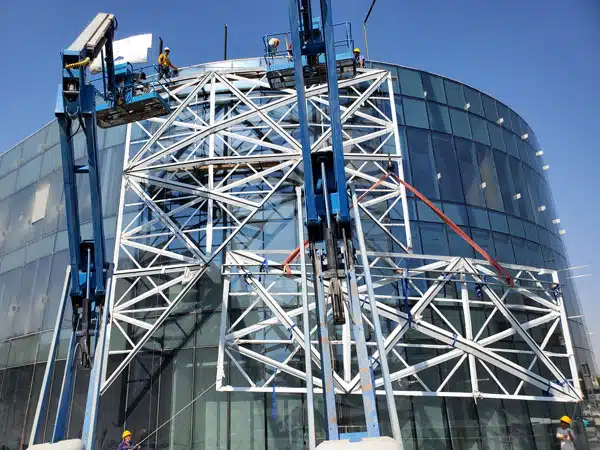
In the background of rapid economy development, curtain walls have become increasingly diverse. This phenomenon fully reflects the trend of increasingly diverse development of curtain wall projects.
On the other hand, the proportion of existing building renovation in curtain wall projects has gradually increased. While some curtain wall systems are different from new curtain walls, and the construction methods have also changed.
To ensure smooth implementation, curtain wall designers should fully consider the characteristics of the system and select construction methods that align with those characteristics to avoid a disconnect between design and execution. At the same time, from the perspective of the entire life cycle of the project, various links such as material selection, processing, assembly, installation, use and post-maintenance should be considered in a comprehensive manner, rather than focusing only on individual factors such as material utilization rate. From the early stages of design, it is essential to consider the structural characteristics and construction methods of curtain walls to ensure effective control throughout the entire lifecycle of the system.
In actual work, if the construction process is not fully considered during the design process and the design relies solely on habitual thinking, the curtain wall installation will be difficult.
Let’s explore the necessity of considering the construction process in the design and provide a reasonable design plan for the entire project process. The following lists several common curtain wall construction processes.
The curtain wall is the maintenance system of the building and the beautiful outer coat that the building wears. As we all know, curtain walls and doors & windows are both commonly used facade forms for buildings. But curtain walls are usually constructed from the outside of the building. While doors and windows can be constructed from the inside of the building.
The stick curtain wall is installed outside the main structure. It is a curtain wall system formed by assembling a grid of vertical mullions and horizontal transoms, onto which panels and decorative elements are installed. In the early years, scaffolding is used as a standard construction approach in some curtain wall projects. Nowadays, suspended platforms (cradles) are more commonly used for installation. In recent years, more convenient construction methods such as self-elevating construction platforms have also emerged.
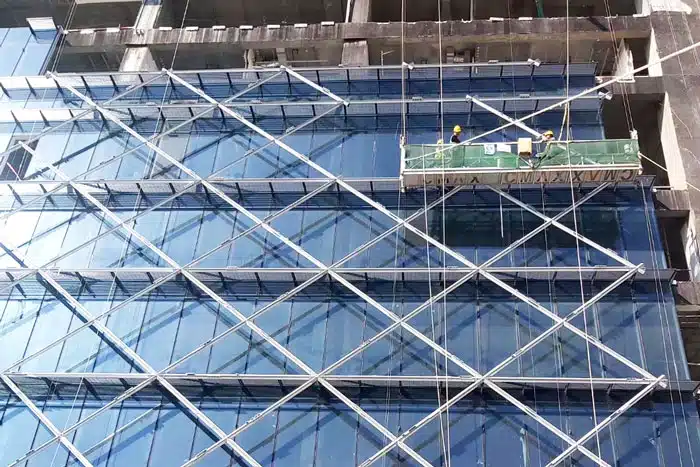
Unitized curtain wall is a type of curtain wall that is assembled in the factory and then directly installed on site. This system offers a high degree of prefabrication and ensures better assembly quality. Its installation method is usually carried out using custom lifting equipment, such as a mobile crane or a circular track. Some unitized curtain walls are equipped with relatively large decorative strips or other components on the outside, which cannot be hoisted together with the unitized curtain wall panels and require secondary installation. At this time, it is necessary to set up a suspended platforms (cradles) on the roof or the circular track to allow the construction workers to perform installation from the building’s exterior. For detailed step-by-step guidance on installation, refer to our Unitized Curtain Wall Installation Guide.
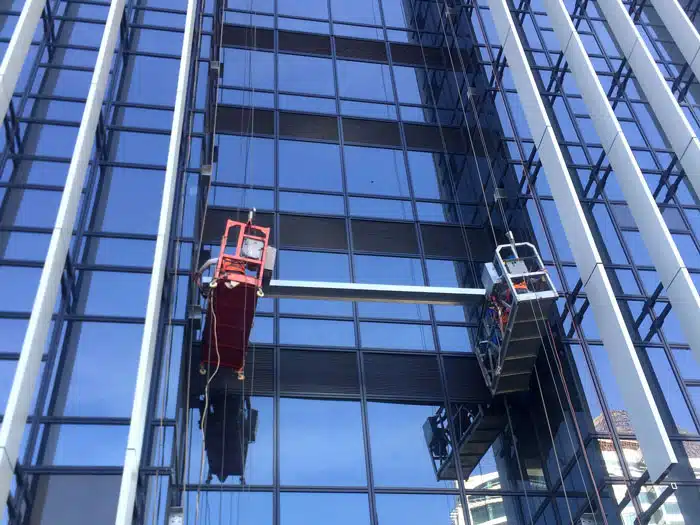
Semi-unitized curtain wall is a curtain wall structure combines features of both unitized and stick systems. In this approach, the main vertical mullions are installed first, followed by the direct hoisting of prefabricated curtain wall panels from the exterior. Since the installation of the curtain wall horizontal transoms can be eliminated, the construction can also be completed from the interior.
In suspended metal curtain wall construction process, the construction workers are lifted to the corresponding position by an aerial work vehicle for the exterior installation. Aerial work vehicles are currently widely used and are suitable for a variety of curtain wall types.
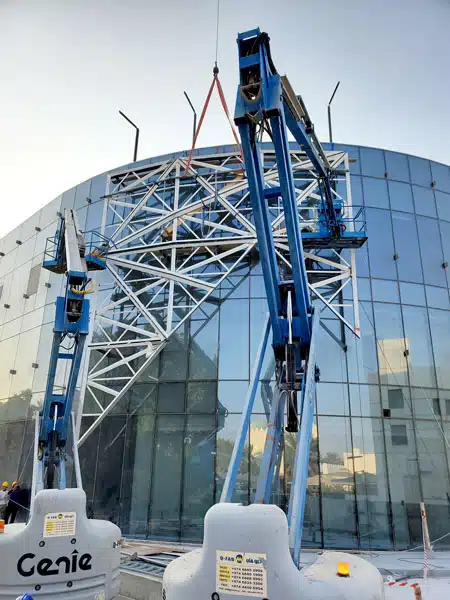
With the continuous development of the curtain wall industry, curtain wall technology is constantly being updated. What’s more, there are more and more curtain wall construction methods, showing the following changes.
2.1 There are many types of powerful construction machinery and tools. Various aerial work vehicles, large cranes, floor rotating cranes, circular tracks, large mobile lifting work platforms and other equipment have greatly facilitated the construction.
2.2 The labor cost of construction is getting higher and higher, and consequently it accounts for an increasing proportion of the curtain wall cost. The dependence degree on construction machinery during curtain wall construction is also getting higher and higher. Through the extensive use of construction machinery, the efficiency of construction personnel is improved. For example, the use of power tools has been very popular, which has improved workers’ installation speed. In addition, some circular tracks are equipped with electric brushes, allowing the lifting system to move freely along the track, thereby significantly improving work efficiency.
2.3 Safety requirements during curtain wall construction are becoming increasingly stringent. As a result, workers must implement proper safety measures throughout the installation process. Moreover, risk classification and safety management protocols are also becoming more detailed and specific.
2.4 Construction planning requirements are becoming increasingly detailed, and the organization of curtain wall construction now demands greater specificity. Many construction tasks within the curtain wall installation process require dedicated work plans. When the curtain wall height exceeds 50 meters, it will be classified as a high-risk project and must undergo a special risk assessment and technical review.
2.5 The variety of specialized curtain walls is increasing. Some curtain walls are no longer simply building maintenance systems with complete building functions, which are very different from the traditional curtain walls. While some special curtain walls are just to meet the architectural requirements of complex forms or façade lighting.
2.6 Curtain wall designs are becoming increasingly complex. To highlight architectural features, more projects are adopting forms such as curved curtain walls, double-curved surfaces, sloped façades, and large cantilevered systems.
In view of the development and changes of curtain walls, curtain wall design should also consider the influence of construction factors. The following aspects can serve as key points of consideration:
Different curtain wall systems have different requirements for curtain wall construction methods. And the choice of system should be based on the specific conditions of the project. For example, buildings with relatively low height and simple geometry are well-suited for stick systems. For super-high-rise regular buildings, unitized curtain walls should be preferred.
From a design perspective, a system with a high assembly rate should be the first choice. This can reduce the work on the construction site. The processing, assembly conditions, labor skills, and product quality of the factory are significantly better than those on site. Therefore, its processing and assembly efficiency is also significantly better than that on site.
Try to use standard construction machinery and reduce the reliance on specialized machinery. For example, use a convenient tool such as a suspended platforms (cradles) to reduce the use of large-scale aerial work platforms.
The safety and convenience of workers should be a primary concern. Installation should be designed to allow workers to operate in safe environments whenever possible. For example, window systems or unitized curtain wall systems allow construction workers to complete construction work indoors. Minimize the need for external work at height.
Considering the operation space for construction workers, sufficient space should be reserved.
This project involved the renovation of an existing building with a height of 60 meters. The top of the building is a cantilever steel structure, under which aluminum panels and glass elements were to be installed with a facade lighting system. Since the building itself is fully functional, the curtain wall system served only a decorative purpose. Besides. there are no performance requirements such as lighting, insulation, and waterproofing.
The curtain wall design adopts standard aluminum plate and glass curtain wall system. The construction workers need to lift it to a height of 60m to install it from the outside and . However, the construction required workers to be lifted 60 meters above ground to install the panels from the outside and seal it with glue. Considering the difficulty of construction, the curtain wall construction team planned to sets up a temporary cantilever steel platform at a high altitude as a working platform. After that, they removed the steel platform when completing the construction. Next, they used the aerial work platform vehicle to supplement the steel platform support structure to reserve the curtain wall gap.
Since the construction operation platform requires a large amount of steel, the welding and assembly costs are high, and it can only be removed after use. Moreover, after the removal of construction platform, it is necessary to cooperate with measures such as aerial vehicles. Therefore, the cost of curtain wall construction far exceeds the fee at the time of bidding. Moreover, it will be difficult to maintain the lighting and curtain walls after the project is completed.
This project is also a renovation of an existing building. The original building is a cylindrical structure with a height of about 50m and no functional architectural requirements. In this renovation, the goal was to add a perforated aluminum curtain wall outside the structure as decoration, along with façade lighting. The added perforated aluminum curtain wall was designed as a twisted double-curved surface, which is fitted by triangular aluminum plates. A steel platform is set up every 3m outside the concrete structure. Vertical aluminum framing members for the façade were then mounted on the outer edges of these platforms.
The construction drawings followed a conventional design approach for perforated aluminum façades, specifying that panels be fixed from the outside. This meant that workers had to operate along the outer surface of the twisting façade to complete installation. Therefore, the primary challenge for the construction team was mainly to solve how to allow construction workers to move along the twisted curtain wall surface. In the end, the construction unit used cable-guided suspended platform system as the main construction machine, and cooperated with inclined rails as auxiliary construction machine. This construction method is costly and time-consuming, due to both the complex geometry and the reliance on specialized equipment.
In summary, the high degree of coordination between curtain wall design and construction has become the key to the successful implementation of modern curtain wall projects. With the diversification of curtain wall types and the continuous advancement of construction technology, designers must abandon traditional thinking patterns and start from actual construction conditions. To put this into practice, several key considerations should guide the design and construction process:
Key Practices for Coordinating Curtain Wall Design and Construction
Factors like structural characteristics, construction methods, safety requirements, and later maintenance should all be addressed.
Fully integrating construction process considerations into the design stage helps avoid repeated rework and cost waste during implementation.
Make sure that the curtain wall system maintains a good balance between functionality, aesthetics, and economy.
Future designs should emphasize the feasibility and controllability of the entire process, providing higher-quality and more efficient facade solutions for buildings.
If designers adhere to these practices, they are likely to realize curtain wall projects that combine aesthetics, functionality, cost-efficiency, safety, and smooth execution throughout their entire lifecycle.

Green Building Trends: Aluminum vs. Stainless Steel for Living Façades As green building shifts from trend to standard, the building’s “skin” is undergoing a transformation.
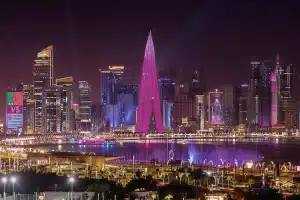
Burj Al Mana Tower: The Story Behind Its Complex Façade and Engineering Rising over Doha’s West Bay, the Burj Al Mana Tower has a story

Every Detail Counts: Understanding SunFrame’s Product Pricing In the world of high-performance windows and curtain walls, every product has a clear cost logic behind it. At
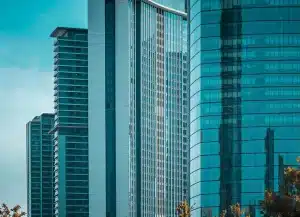
How Spatial Utilization Drives Curtain Wall Selection —A Deeper Look into Light, Energy, and Space Introduction In modern architecture, curtain walls have moved beyond decoration